Adolescent Psychology Assignment: Parenting, Conflict, Pregnancy
VerifiedAdded on 2023/01/06
|9
|2830
|52
Homework Assignment
AI Summary
This assignment on adolescent psychology explores various aspects of adolescent development and the challenges faced by teenagers. It begins by defining and providing examples of different parenting styles, including authoritative, authoritarian, neglectful, and permissive. The assignment then prompts a reflection on the student's own experiences, asking them to identify their parents' parenting style and recall a significant conflict from their adolescent years, inferring the causes of tension. Furthermore, it delves into the issue of teenage pregnancy in Sarawak, discussing four social risk factors, inferring the socioeconomic and psychological consequences for teen mothers and the developmental conditions of their children, and suggesting interventions to prevent unwanted pregnancies. The assignment concludes by emphasizing the importance of communication and understanding in the parent-adolescent relationship and the need for comprehensive sexual and reproductive health education.
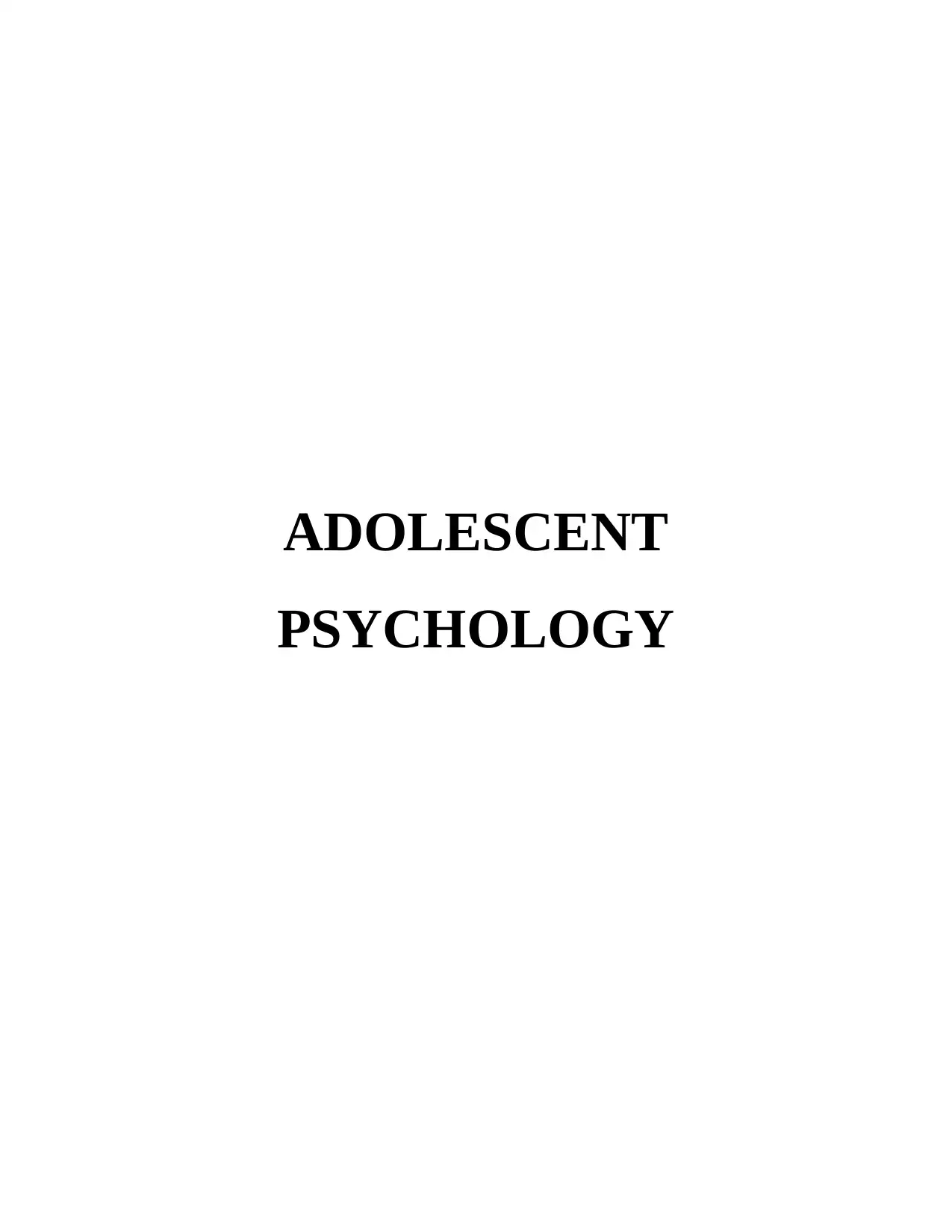
ADOLESCENT
PSYCHOLOGY
PSYCHOLOGY
Paraphrase This Document
Need a fresh take? Get an instant paraphrase of this document with our AI Paraphraser
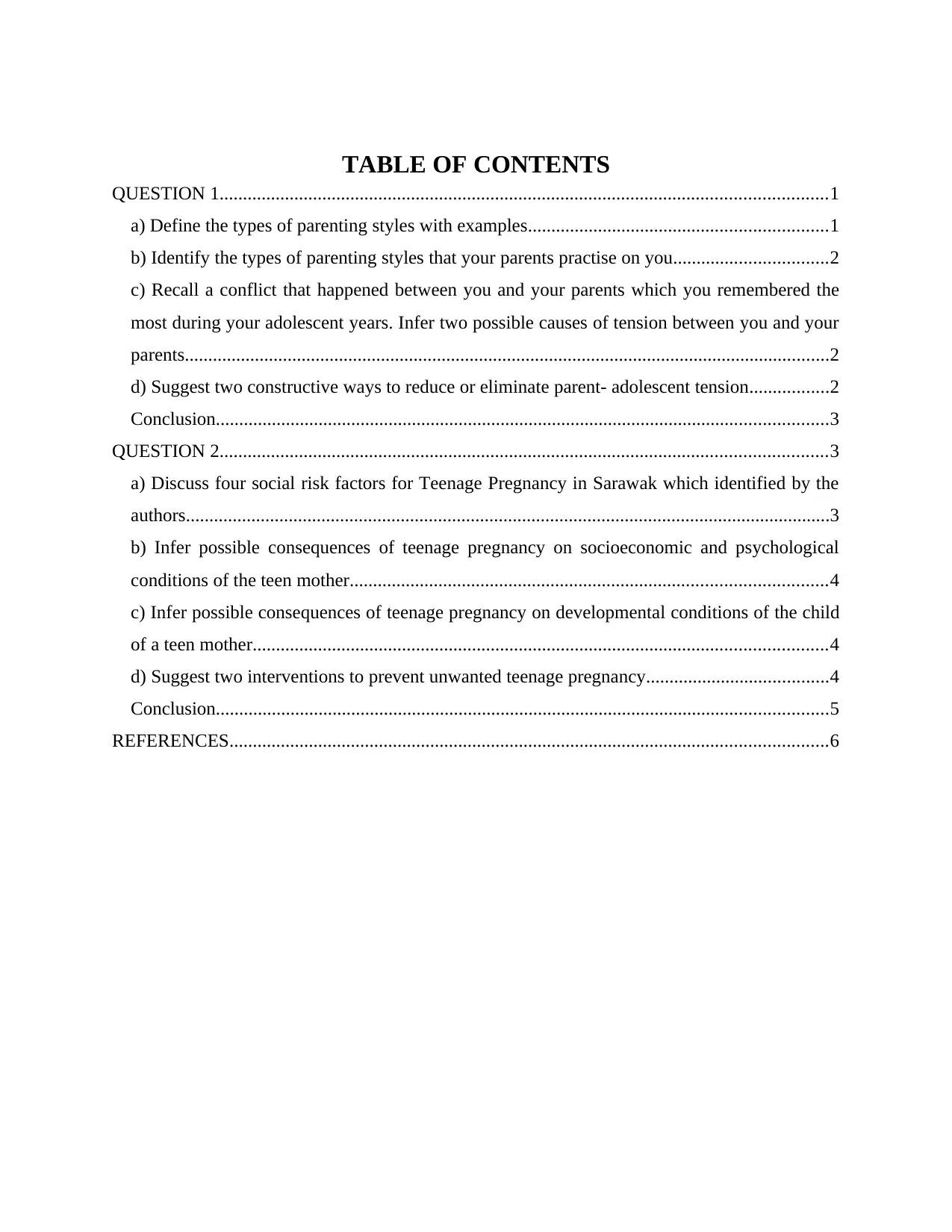
TABLE OF CONTENTS
QUESTION 1..................................................................................................................................1
a) Define the types of parenting styles with examples................................................................1
b) Identify the types of parenting styles that your parents practise on you.................................2
c) Recall a conflict that happened between you and your parents which you remembered the
most during your adolescent years. Infer two possible causes of tension between you and your
parents..........................................................................................................................................2
d) Suggest two constructive ways to reduce or eliminate parent- adolescent tension.................2
Conclusion...................................................................................................................................3
QUESTION 2..................................................................................................................................3
a) Discuss four social risk factors for Teenage Pregnancy in Sarawak which identified by the
authors..........................................................................................................................................3
b) Infer possible consequences of teenage pregnancy on socioeconomic and psychological
conditions of the teen mother......................................................................................................4
c) Infer possible consequences of teenage pregnancy on developmental conditions of the child
of a teen mother...........................................................................................................................4
d) Suggest two interventions to prevent unwanted teenage pregnancy.......................................4
Conclusion...................................................................................................................................5
REFERENCES................................................................................................................................6
QUESTION 1..................................................................................................................................1
a) Define the types of parenting styles with examples................................................................1
b) Identify the types of parenting styles that your parents practise on you.................................2
c) Recall a conflict that happened between you and your parents which you remembered the
most during your adolescent years. Infer two possible causes of tension between you and your
parents..........................................................................................................................................2
d) Suggest two constructive ways to reduce or eliminate parent- adolescent tension.................2
Conclusion...................................................................................................................................3
QUESTION 2..................................................................................................................................3
a) Discuss four social risk factors for Teenage Pregnancy in Sarawak which identified by the
authors..........................................................................................................................................3
b) Infer possible consequences of teenage pregnancy on socioeconomic and psychological
conditions of the teen mother......................................................................................................4
c) Infer possible consequences of teenage pregnancy on developmental conditions of the child
of a teen mother...........................................................................................................................4
d) Suggest two interventions to prevent unwanted teenage pregnancy.......................................4
Conclusion...................................................................................................................................5
REFERENCES................................................................................................................................6
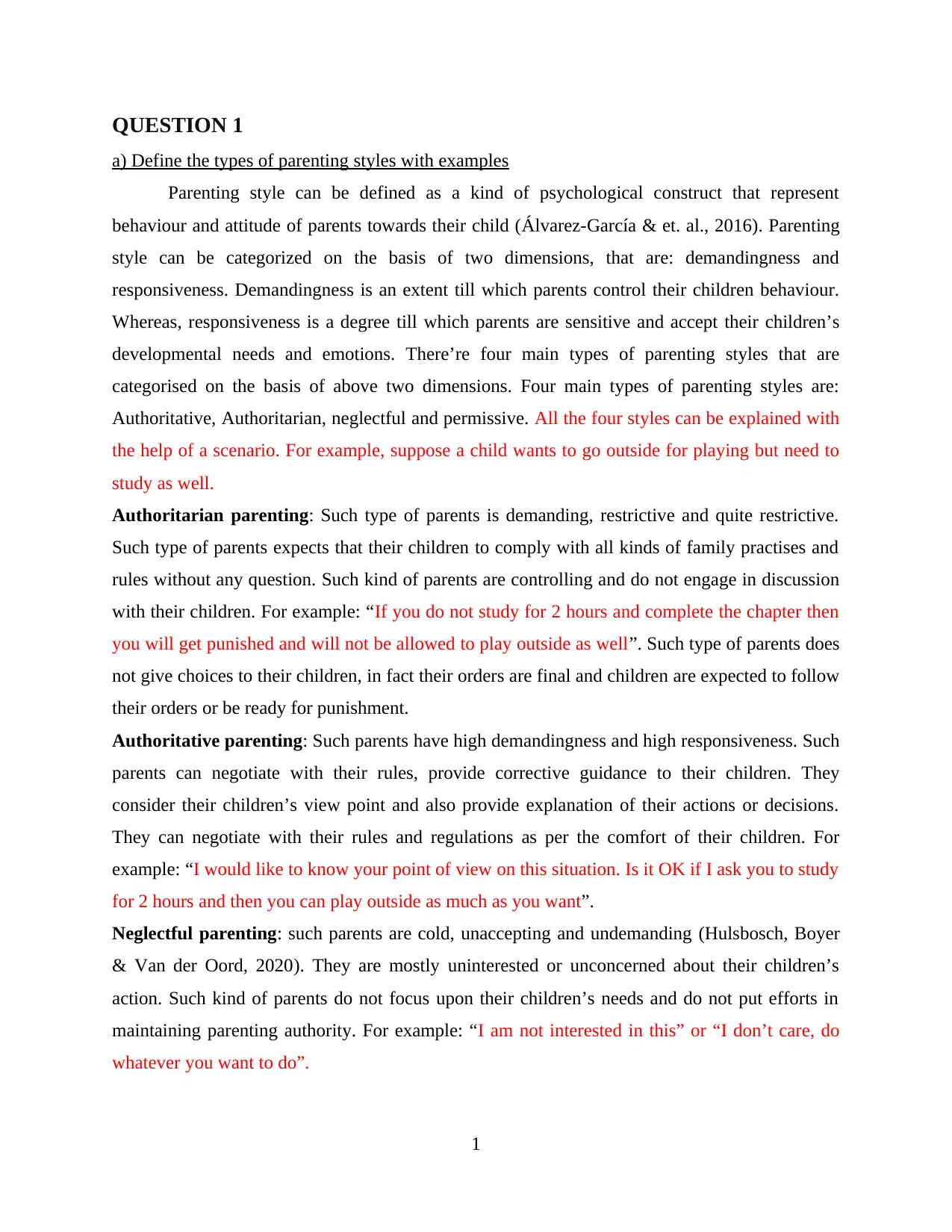
QUESTION 1
a) Define the types of parenting styles with examples
Parenting style can be defined as a kind of psychological construct that represent
behaviour and attitude of parents towards their child (Álvarez-García & et. al., 2016). Parenting
style can be categorized on the basis of two dimensions, that are: demandingness and
responsiveness. Demandingness is an extent till which parents control their children behaviour.
Whereas, responsiveness is a degree till which parents are sensitive and accept their children’s
developmental needs and emotions. There’re four main types of parenting styles that are
categorised on the basis of above two dimensions. Four main types of parenting styles are:
Authoritative, Authoritarian, neglectful and permissive. All the four styles can be explained with
the help of a scenario. For example, suppose a child wants to go outside for playing but need to
study as well.
Authoritarian parenting: Such type of parents is demanding, restrictive and quite restrictive.
Such type of parents expects that their children to comply with all kinds of family practises and
rules without any question. Such kind of parents are controlling and do not engage in discussion
with their children. For example: “If you do not study for 2 hours and complete the chapter then
you will get punished and will not be allowed to play outside as well”. Such type of parents does
not give choices to their children, in fact their orders are final and children are expected to follow
their orders or be ready for punishment.
Authoritative parenting: Such parents have high demandingness and high responsiveness. Such
parents can negotiate with their rules, provide corrective guidance to their children. They
consider their children’s view point and also provide explanation of their actions or decisions.
They can negotiate with their rules and regulations as per the comfort of their children. For
example: “I would like to know your point of view on this situation. Is it OK if I ask you to study
for 2 hours and then you can play outside as much as you want”.
Neglectful parenting: such parents are cold, unaccepting and undemanding (Hulsbosch, Boyer
& Van der Oord, 2020). They are mostly uninterested or unconcerned about their children’s
action. Such kind of parents do not focus upon their children’s needs and do not put efforts in
maintaining parenting authority. For example: “I am not interested in this” or “I don’t care, do
whatever you want to do”.
1
a) Define the types of parenting styles with examples
Parenting style can be defined as a kind of psychological construct that represent
behaviour and attitude of parents towards their child (Álvarez-García & et. al., 2016). Parenting
style can be categorized on the basis of two dimensions, that are: demandingness and
responsiveness. Demandingness is an extent till which parents control their children behaviour.
Whereas, responsiveness is a degree till which parents are sensitive and accept their children’s
developmental needs and emotions. There’re four main types of parenting styles that are
categorised on the basis of above two dimensions. Four main types of parenting styles are:
Authoritative, Authoritarian, neglectful and permissive. All the four styles can be explained with
the help of a scenario. For example, suppose a child wants to go outside for playing but need to
study as well.
Authoritarian parenting: Such type of parents is demanding, restrictive and quite restrictive.
Such type of parents expects that their children to comply with all kinds of family practises and
rules without any question. Such kind of parents are controlling and do not engage in discussion
with their children. For example: “If you do not study for 2 hours and complete the chapter then
you will get punished and will not be allowed to play outside as well”. Such type of parents does
not give choices to their children, in fact their orders are final and children are expected to follow
their orders or be ready for punishment.
Authoritative parenting: Such parents have high demandingness and high responsiveness. Such
parents can negotiate with their rules, provide corrective guidance to their children. They
consider their children’s view point and also provide explanation of their actions or decisions.
They can negotiate with their rules and regulations as per the comfort of their children. For
example: “I would like to know your point of view on this situation. Is it OK if I ask you to study
for 2 hours and then you can play outside as much as you want”.
Neglectful parenting: such parents are cold, unaccepting and undemanding (Hulsbosch, Boyer
& Van der Oord, 2020). They are mostly uninterested or unconcerned about their children’s
action. Such kind of parents do not focus upon their children’s needs and do not put efforts in
maintaining parenting authority. For example: “I am not interested in this” or “I don’t care, do
whatever you want to do”.
1
⊘ This is a preview!⊘
Do you want full access?
Subscribe today to unlock all pages.

Trusted by 1+ million students worldwide
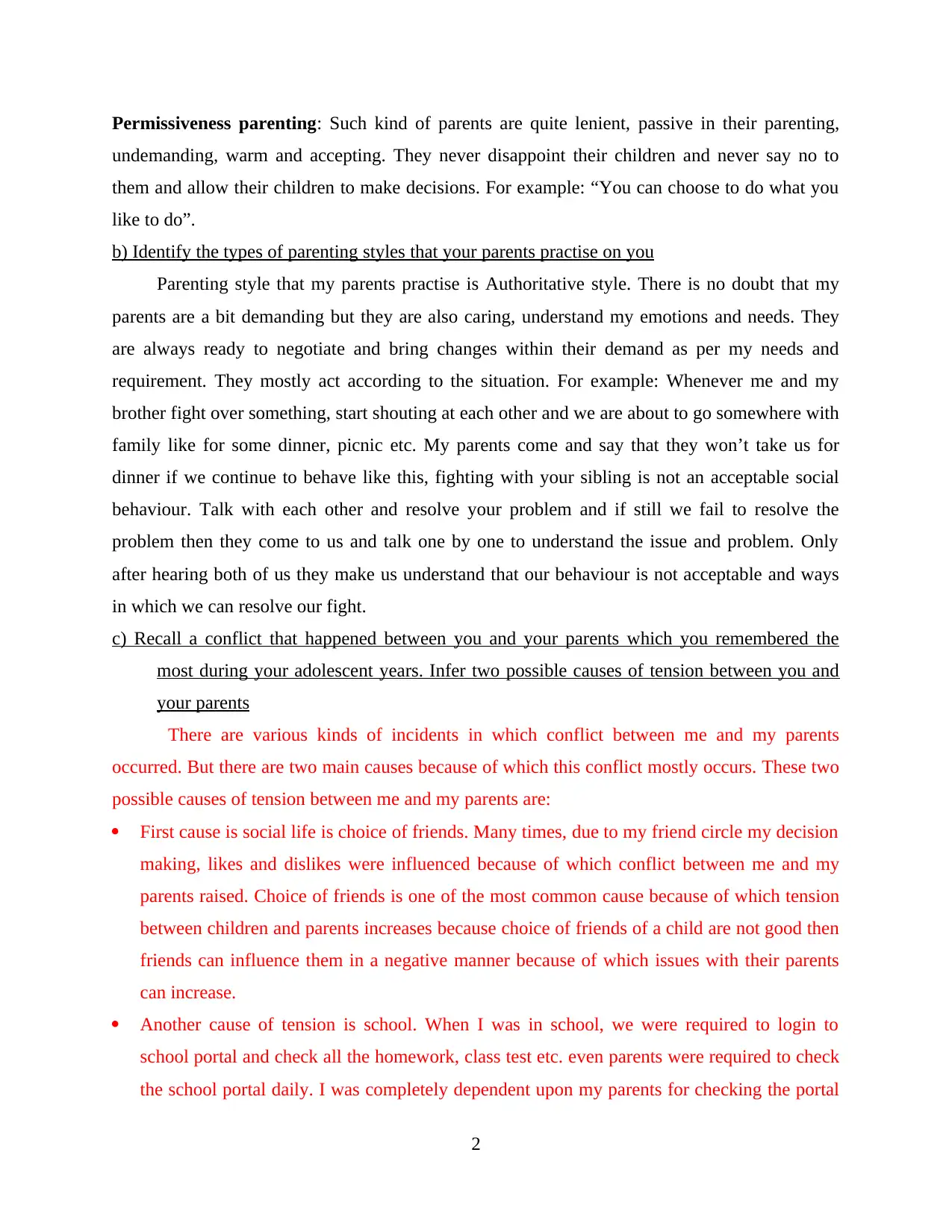
Permissiveness parenting: Such kind of parents are quite lenient, passive in their parenting,
undemanding, warm and accepting. They never disappoint their children and never say no to
them and allow their children to make decisions. For example: “You can choose to do what you
like to do”.
b) Identify the types of parenting styles that your parents practise on you
Parenting style that my parents practise is Authoritative style. There is no doubt that my
parents are a bit demanding but they are also caring, understand my emotions and needs. They
are always ready to negotiate and bring changes within their demand as per my needs and
requirement. They mostly act according to the situation. For example: Whenever me and my
brother fight over something, start shouting at each other and we are about to go somewhere with
family like for some dinner, picnic etc. My parents come and say that they won’t take us for
dinner if we continue to behave like this, fighting with your sibling is not an acceptable social
behaviour. Talk with each other and resolve your problem and if still we fail to resolve the
problem then they come to us and talk one by one to understand the issue and problem. Only
after hearing both of us they make us understand that our behaviour is not acceptable and ways
in which we can resolve our fight.
c) Recall a conflict that happened between you and your parents which you remembered the
most during your adolescent years. Infer two possible causes of tension between you and
your parents
There are various kinds of incidents in which conflict between me and my parents
occurred. But there are two main causes because of which this conflict mostly occurs. These two
possible causes of tension between me and my parents are:
First cause is social life is choice of friends. Many times, due to my friend circle my decision
making, likes and dislikes were influenced because of which conflict between me and my
parents raised. Choice of friends is one of the most common cause because of which tension
between children and parents increases because choice of friends of a child are not good then
friends can influence them in a negative manner because of which issues with their parents
can increase.
Another cause of tension is school. When I was in school, we were required to login to
school portal and check all the homework, class test etc. even parents were required to check
the school portal daily. I was completely dependent upon my parents for checking the portal
2
undemanding, warm and accepting. They never disappoint their children and never say no to
them and allow their children to make decisions. For example: “You can choose to do what you
like to do”.
b) Identify the types of parenting styles that your parents practise on you
Parenting style that my parents practise is Authoritative style. There is no doubt that my
parents are a bit demanding but they are also caring, understand my emotions and needs. They
are always ready to negotiate and bring changes within their demand as per my needs and
requirement. They mostly act according to the situation. For example: Whenever me and my
brother fight over something, start shouting at each other and we are about to go somewhere with
family like for some dinner, picnic etc. My parents come and say that they won’t take us for
dinner if we continue to behave like this, fighting with your sibling is not an acceptable social
behaviour. Talk with each other and resolve your problem and if still we fail to resolve the
problem then they come to us and talk one by one to understand the issue and problem. Only
after hearing both of us they make us understand that our behaviour is not acceptable and ways
in which we can resolve our fight.
c) Recall a conflict that happened between you and your parents which you remembered the
most during your adolescent years. Infer two possible causes of tension between you and
your parents
There are various kinds of incidents in which conflict between me and my parents
occurred. But there are two main causes because of which this conflict mostly occurs. These two
possible causes of tension between me and my parents are:
First cause is social life is choice of friends. Many times, due to my friend circle my decision
making, likes and dislikes were influenced because of which conflict between me and my
parents raised. Choice of friends is one of the most common cause because of which tension
between children and parents increases because choice of friends of a child are not good then
friends can influence them in a negative manner because of which issues with their parents
can increase.
Another cause of tension is school. When I was in school, we were required to login to
school portal and check all the homework, class test etc. even parents were required to check
the school portal daily. I was completely dependent upon my parents for checking the portal
2
Paraphrase This Document
Need a fresh take? Get an instant paraphrase of this document with our AI Paraphraser
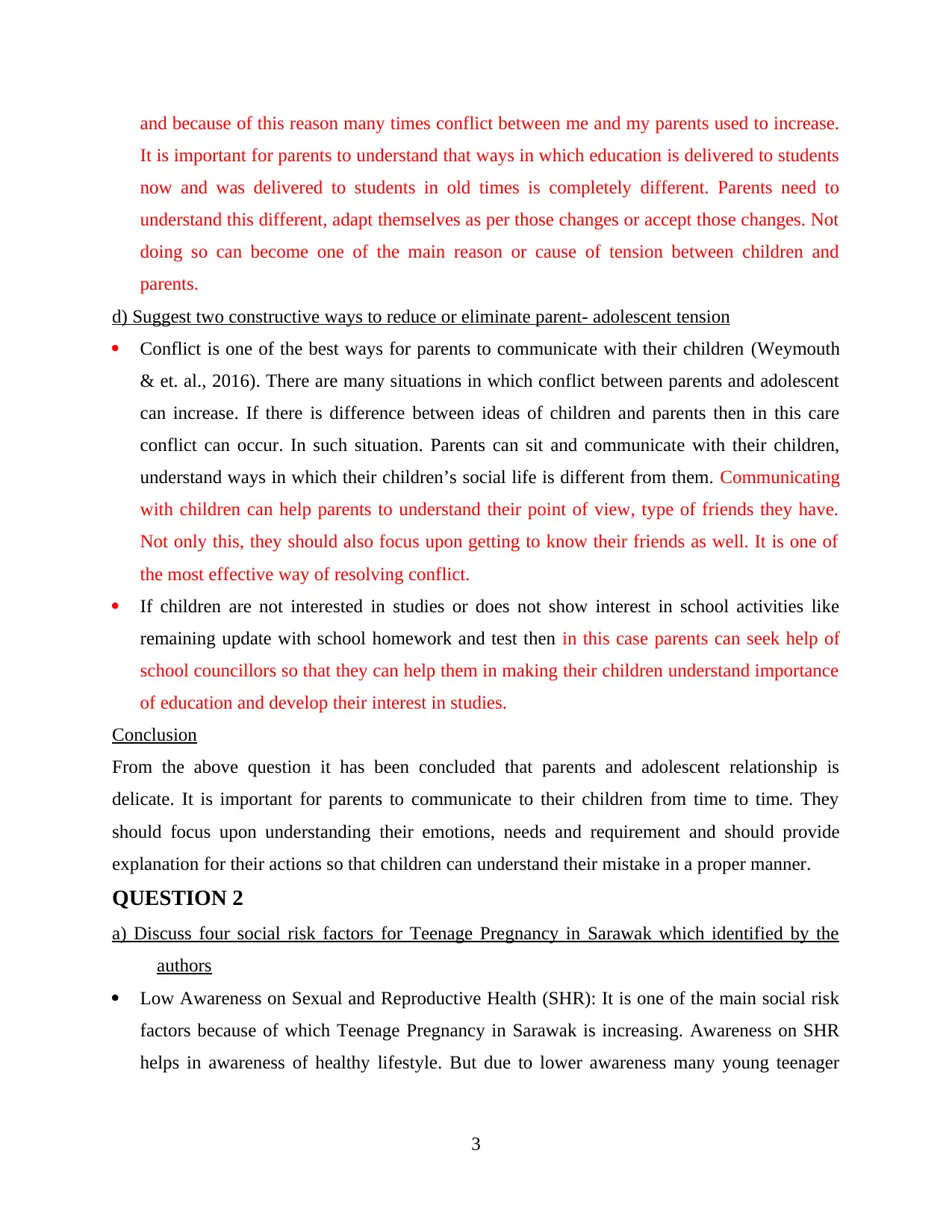
and because of this reason many times conflict between me and my parents used to increase.
It is important for parents to understand that ways in which education is delivered to students
now and was delivered to students in old times is completely different. Parents need to
understand this different, adapt themselves as per those changes or accept those changes. Not
doing so can become one of the main reason or cause of tension between children and
parents.
d) Suggest two constructive ways to reduce or eliminate parent- adolescent tension
Conflict is one of the best ways for parents to communicate with their children (Weymouth
& et. al., 2016). There are many situations in which conflict between parents and adolescent
can increase. If there is difference between ideas of children and parents then in this care
conflict can occur. In such situation. Parents can sit and communicate with their children,
understand ways in which their children’s social life is different from them. Communicating
with children can help parents to understand their point of view, type of friends they have.
Not only this, they should also focus upon getting to know their friends as well. It is one of
the most effective way of resolving conflict.
If children are not interested in studies or does not show interest in school activities like
remaining update with school homework and test then in this case parents can seek help of
school councillors so that they can help them in making their children understand importance
of education and develop their interest in studies.
Conclusion
From the above question it has been concluded that parents and adolescent relationship is
delicate. It is important for parents to communicate to their children from time to time. They
should focus upon understanding their emotions, needs and requirement and should provide
explanation for their actions so that children can understand their mistake in a proper manner.
QUESTION 2
a) Discuss four social risk factors for Teenage Pregnancy in Sarawak which identified by the
authors
Low Awareness on Sexual and Reproductive Health (SHR): It is one of the main social risk
factors because of which Teenage Pregnancy in Sarawak is increasing. Awareness on SHR
helps in awareness of healthy lifestyle. But due to lower awareness many young teenager
3
It is important for parents to understand that ways in which education is delivered to students
now and was delivered to students in old times is completely different. Parents need to
understand this different, adapt themselves as per those changes or accept those changes. Not
doing so can become one of the main reason or cause of tension between children and
parents.
d) Suggest two constructive ways to reduce or eliminate parent- adolescent tension
Conflict is one of the best ways for parents to communicate with their children (Weymouth
& et. al., 2016). There are many situations in which conflict between parents and adolescent
can increase. If there is difference between ideas of children and parents then in this care
conflict can occur. In such situation. Parents can sit and communicate with their children,
understand ways in which their children’s social life is different from them. Communicating
with children can help parents to understand their point of view, type of friends they have.
Not only this, they should also focus upon getting to know their friends as well. It is one of
the most effective way of resolving conflict.
If children are not interested in studies or does not show interest in school activities like
remaining update with school homework and test then in this case parents can seek help of
school councillors so that they can help them in making their children understand importance
of education and develop their interest in studies.
Conclusion
From the above question it has been concluded that parents and adolescent relationship is
delicate. It is important for parents to communicate to their children from time to time. They
should focus upon understanding their emotions, needs and requirement and should provide
explanation for their actions so that children can understand their mistake in a proper manner.
QUESTION 2
a) Discuss four social risk factors for Teenage Pregnancy in Sarawak which identified by the
authors
Low Awareness on Sexual and Reproductive Health (SHR): It is one of the main social risk
factors because of which Teenage Pregnancy in Sarawak is increasing. Awareness on SHR
helps in awareness of healthy lifestyle. But due to lower awareness many young teenager
3
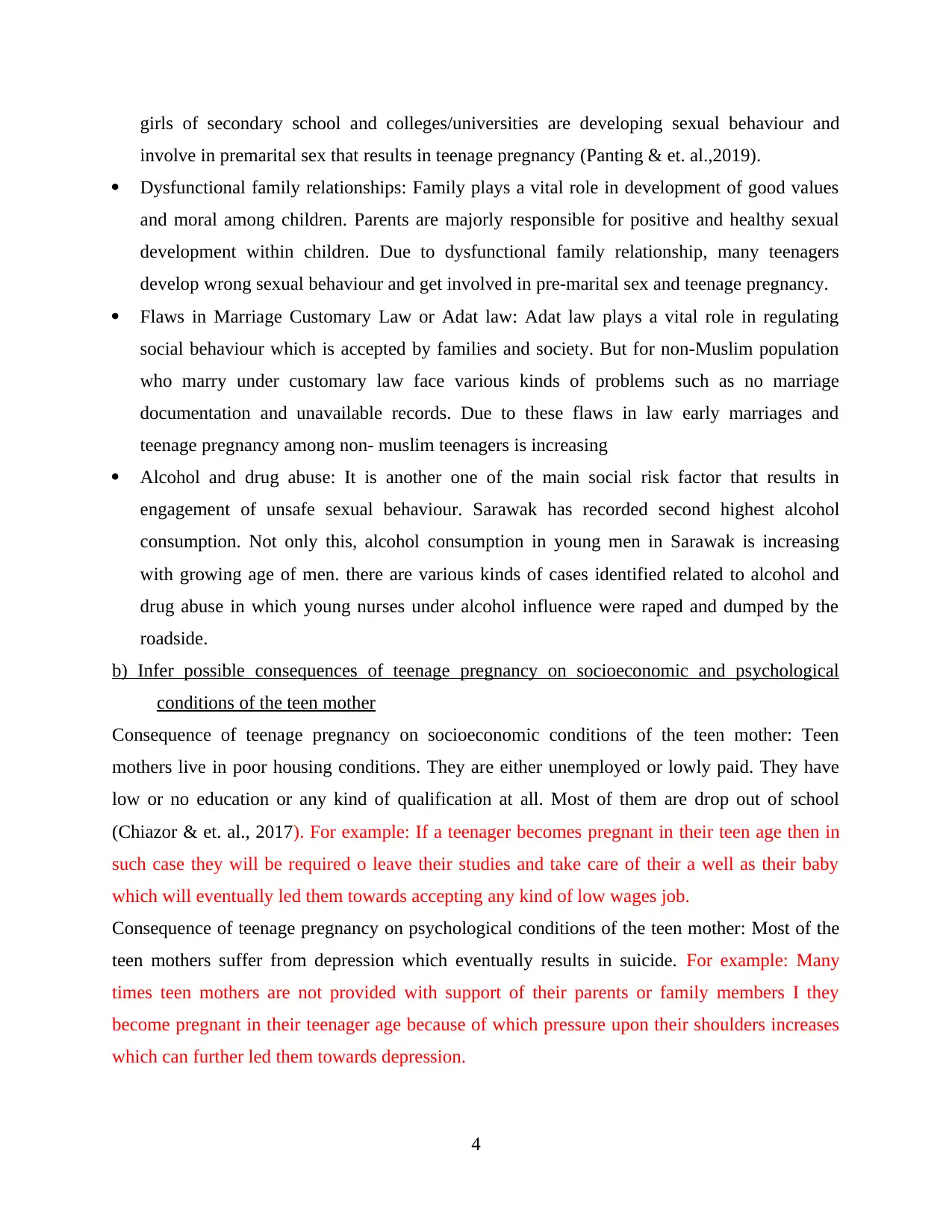
girls of secondary school and colleges/universities are developing sexual behaviour and
involve in premarital sex that results in teenage pregnancy (Panting & et. al.,2019).
Dysfunctional family relationships: Family plays a vital role in development of good values
and moral among children. Parents are majorly responsible for positive and healthy sexual
development within children. Due to dysfunctional family relationship, many teenagers
develop wrong sexual behaviour and get involved in pre-marital sex and teenage pregnancy.
Flaws in Marriage Customary Law or Adat law: Adat law plays a vital role in regulating
social behaviour which is accepted by families and society. But for non-Muslim population
who marry under customary law face various kinds of problems such as no marriage
documentation and unavailable records. Due to these flaws in law early marriages and
teenage pregnancy among non- muslim teenagers is increasing
Alcohol and drug abuse: It is another one of the main social risk factor that results in
engagement of unsafe sexual behaviour. Sarawak has recorded second highest alcohol
consumption. Not only this, alcohol consumption in young men in Sarawak is increasing
with growing age of men. there are various kinds of cases identified related to alcohol and
drug abuse in which young nurses under alcohol influence were raped and dumped by the
roadside.
b) Infer possible consequences of teenage pregnancy on socioeconomic and psychological
conditions of the teen mother
Consequence of teenage pregnancy on socioeconomic conditions of the teen mother: Teen
mothers live in poor housing conditions. They are either unemployed or lowly paid. They have
low or no education or any kind of qualification at all. Most of them are drop out of school
(Chiazor & et. al., 2017). For example: If a teenager becomes pregnant in their teen age then in
such case they will be required o leave their studies and take care of their a well as their baby
which will eventually led them towards accepting any kind of low wages job.
Consequence of teenage pregnancy on psychological conditions of the teen mother: Most of the
teen mothers suffer from depression which eventually results in suicide. For example: Many
times teen mothers are not provided with support of their parents or family members I they
become pregnant in their teenager age because of which pressure upon their shoulders increases
which can further led them towards depression.
4
involve in premarital sex that results in teenage pregnancy (Panting & et. al.,2019).
Dysfunctional family relationships: Family plays a vital role in development of good values
and moral among children. Parents are majorly responsible for positive and healthy sexual
development within children. Due to dysfunctional family relationship, many teenagers
develop wrong sexual behaviour and get involved in pre-marital sex and teenage pregnancy.
Flaws in Marriage Customary Law or Adat law: Adat law plays a vital role in regulating
social behaviour which is accepted by families and society. But for non-Muslim population
who marry under customary law face various kinds of problems such as no marriage
documentation and unavailable records. Due to these flaws in law early marriages and
teenage pregnancy among non- muslim teenagers is increasing
Alcohol and drug abuse: It is another one of the main social risk factor that results in
engagement of unsafe sexual behaviour. Sarawak has recorded second highest alcohol
consumption. Not only this, alcohol consumption in young men in Sarawak is increasing
with growing age of men. there are various kinds of cases identified related to alcohol and
drug abuse in which young nurses under alcohol influence were raped and dumped by the
roadside.
b) Infer possible consequences of teenage pregnancy on socioeconomic and psychological
conditions of the teen mother
Consequence of teenage pregnancy on socioeconomic conditions of the teen mother: Teen
mothers live in poor housing conditions. They are either unemployed or lowly paid. They have
low or no education or any kind of qualification at all. Most of them are drop out of school
(Chiazor & et. al., 2017). For example: If a teenager becomes pregnant in their teen age then in
such case they will be required o leave their studies and take care of their a well as their baby
which will eventually led them towards accepting any kind of low wages job.
Consequence of teenage pregnancy on psychological conditions of the teen mother: Most of the
teen mothers suffer from depression which eventually results in suicide. For example: Many
times teen mothers are not provided with support of their parents or family members I they
become pregnant in their teenager age because of which pressure upon their shoulders increases
which can further led them towards depression.
4
⊘ This is a preview!⊘
Do you want full access?
Subscribe today to unlock all pages.

Trusted by 1+ million students worldwide
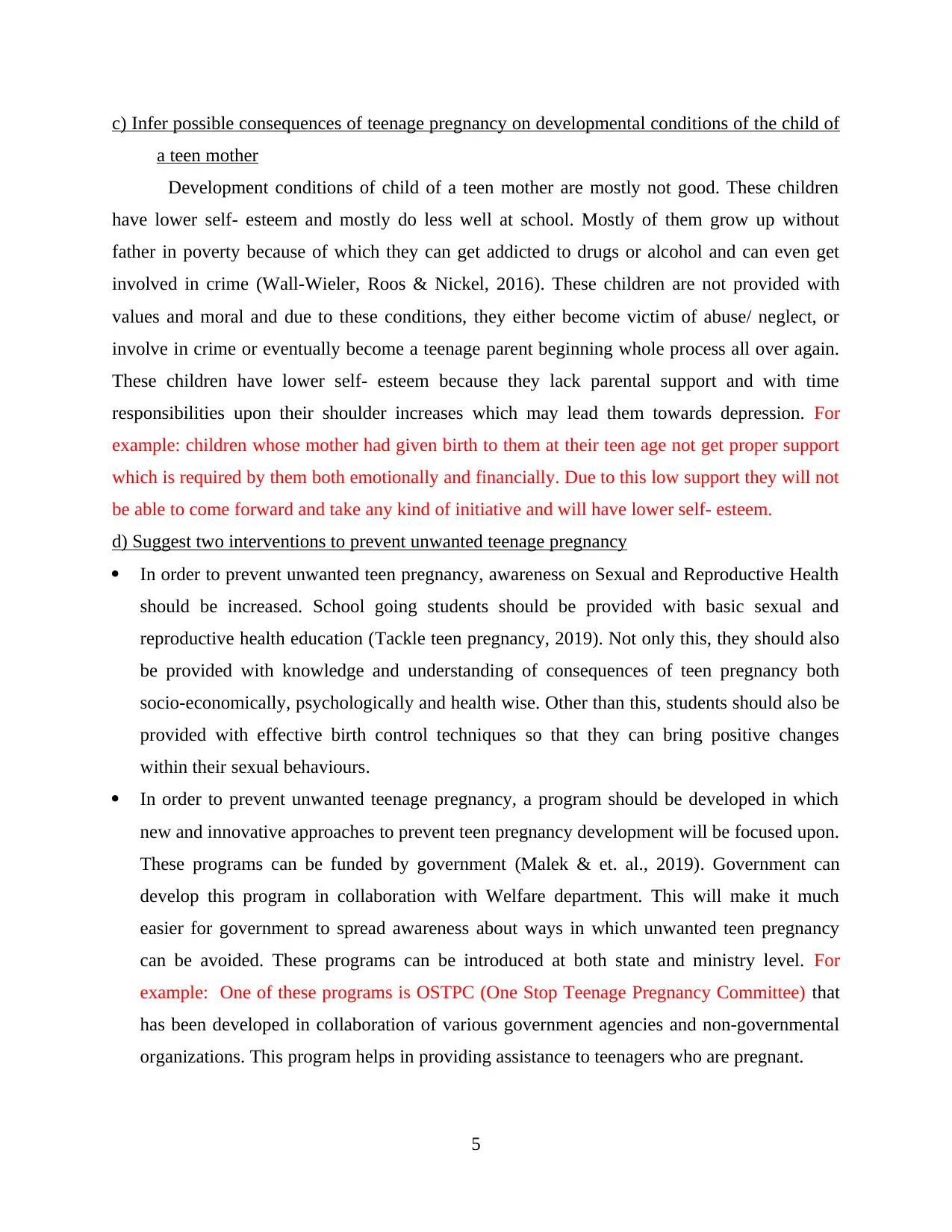
c) Infer possible consequences of teenage pregnancy on developmental conditions of the child of
a teen mother
Development conditions of child of a teen mother are mostly not good. These children
have lower self- esteem and mostly do less well at school. Mostly of them grow up without
father in poverty because of which they can get addicted to drugs or alcohol and can even get
involved in crime (Wall-Wieler, Roos & Nickel, 2016). These children are not provided with
values and moral and due to these conditions, they either become victim of abuse/ neglect, or
involve in crime or eventually become a teenage parent beginning whole process all over again.
These children have lower self- esteem because they lack parental support and with time
responsibilities upon their shoulder increases which may lead them towards depression. For
example: children whose mother had given birth to them at their teen age not get proper support
which is required by them both emotionally and financially. Due to this low support they will not
be able to come forward and take any kind of initiative and will have lower self- esteem.
d) Suggest two interventions to prevent unwanted teenage pregnancy
In order to prevent unwanted teen pregnancy, awareness on Sexual and Reproductive Health
should be increased. School going students should be provided with basic sexual and
reproductive health education (Tackle teen pregnancy, 2019). Not only this, they should also
be provided with knowledge and understanding of consequences of teen pregnancy both
socio-economically, psychologically and health wise. Other than this, students should also be
provided with effective birth control techniques so that they can bring positive changes
within their sexual behaviours.
In order to prevent unwanted teenage pregnancy, a program should be developed in which
new and innovative approaches to prevent teen pregnancy development will be focused upon.
These programs can be funded by government (Malek & et. al., 2019). Government can
develop this program in collaboration with Welfare department. This will make it much
easier for government to spread awareness about ways in which unwanted teen pregnancy
can be avoided. These programs can be introduced at both state and ministry level. For
example: One of these programs is OSTPC (One Stop Teenage Pregnancy Committee) that
has been developed in collaboration of various government agencies and non-governmental
organizations. This program helps in providing assistance to teenagers who are pregnant.
5
a teen mother
Development conditions of child of a teen mother are mostly not good. These children
have lower self- esteem and mostly do less well at school. Mostly of them grow up without
father in poverty because of which they can get addicted to drugs or alcohol and can even get
involved in crime (Wall-Wieler, Roos & Nickel, 2016). These children are not provided with
values and moral and due to these conditions, they either become victim of abuse/ neglect, or
involve in crime or eventually become a teenage parent beginning whole process all over again.
These children have lower self- esteem because they lack parental support and with time
responsibilities upon their shoulder increases which may lead them towards depression. For
example: children whose mother had given birth to them at their teen age not get proper support
which is required by them both emotionally and financially. Due to this low support they will not
be able to come forward and take any kind of initiative and will have lower self- esteem.
d) Suggest two interventions to prevent unwanted teenage pregnancy
In order to prevent unwanted teen pregnancy, awareness on Sexual and Reproductive Health
should be increased. School going students should be provided with basic sexual and
reproductive health education (Tackle teen pregnancy, 2019). Not only this, they should also
be provided with knowledge and understanding of consequences of teen pregnancy both
socio-economically, psychologically and health wise. Other than this, students should also be
provided with effective birth control techniques so that they can bring positive changes
within their sexual behaviours.
In order to prevent unwanted teenage pregnancy, a program should be developed in which
new and innovative approaches to prevent teen pregnancy development will be focused upon.
These programs can be funded by government (Malek & et. al., 2019). Government can
develop this program in collaboration with Welfare department. This will make it much
easier for government to spread awareness about ways in which unwanted teen pregnancy
can be avoided. These programs can be introduced at both state and ministry level. For
example: One of these programs is OSTPC (One Stop Teenage Pregnancy Committee) that
has been developed in collaboration of various government agencies and non-governmental
organizations. This program helps in providing assistance to teenagers who are pregnant.
5
Paraphrase This Document
Need a fresh take? Get an instant paraphrase of this document with our AI Paraphraser
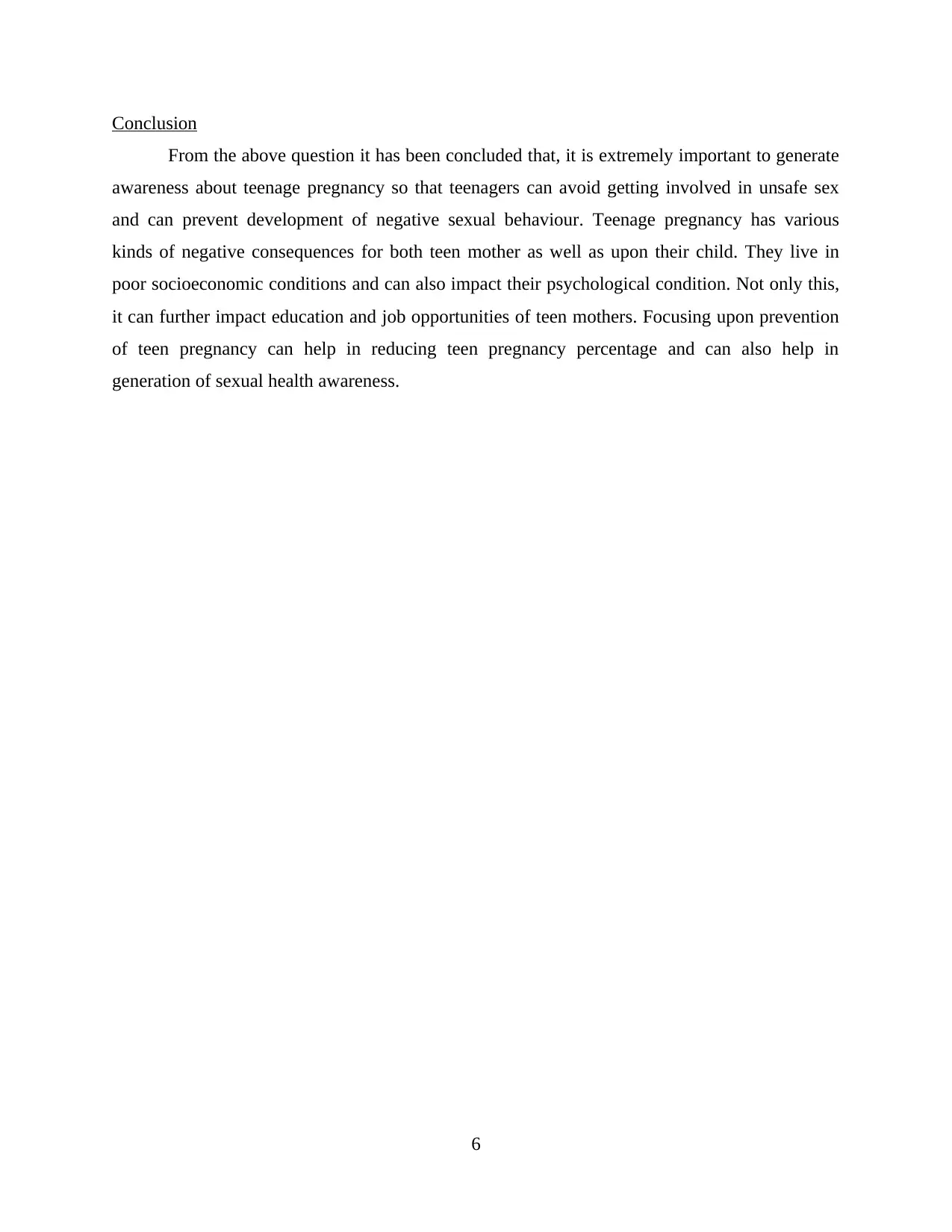
Conclusion
From the above question it has been concluded that, it is extremely important to generate
awareness about teenage pregnancy so that teenagers can avoid getting involved in unsafe sex
and can prevent development of negative sexual behaviour. Teenage pregnancy has various
kinds of negative consequences for both teen mother as well as upon their child. They live in
poor socioeconomic conditions and can also impact their psychological condition. Not only this,
it can further impact education and job opportunities of teen mothers. Focusing upon prevention
of teen pregnancy can help in reducing teen pregnancy percentage and can also help in
generation of sexual health awareness.
6
From the above question it has been concluded that, it is extremely important to generate
awareness about teenage pregnancy so that teenagers can avoid getting involved in unsafe sex
and can prevent development of negative sexual behaviour. Teenage pregnancy has various
kinds of negative consequences for both teen mother as well as upon their child. They live in
poor socioeconomic conditions and can also impact their psychological condition. Not only this,
it can further impact education and job opportunities of teen mothers. Focusing upon prevention
of teen pregnancy can help in reducing teen pregnancy percentage and can also help in
generation of sexual health awareness.
6
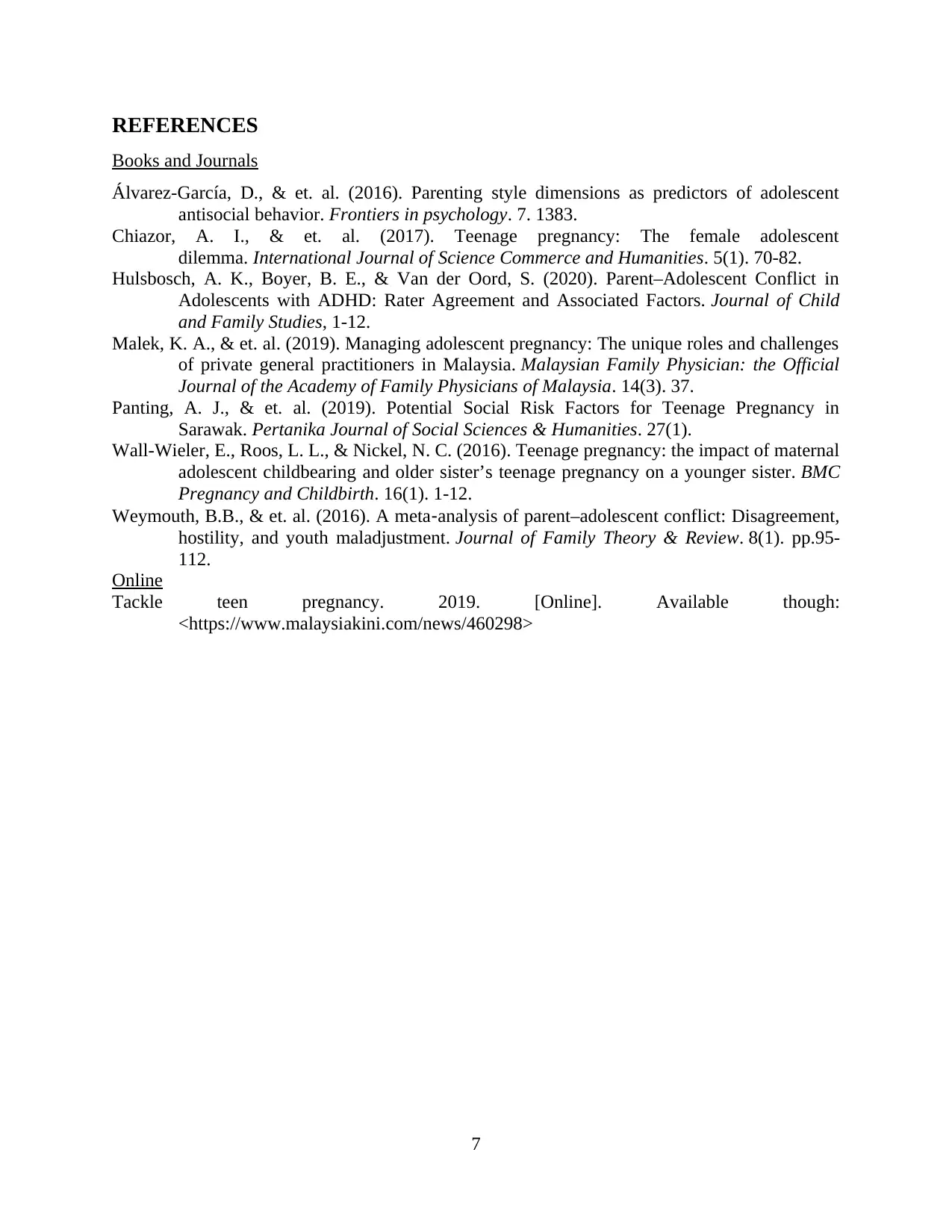
REFERENCES
Books and Journals
Álvarez-García, D., & et. al. (2016). Parenting style dimensions as predictors of adolescent
antisocial behavior. Frontiers in psychology. 7. 1383.
Chiazor, A. I., & et. al. (2017). Teenage pregnancy: The female adolescent
dilemma. International Journal of Science Commerce and Humanities. 5(1). 70-82.
Hulsbosch, A. K., Boyer, B. E., & Van der Oord, S. (2020). Parent–Adolescent Conflict in
Adolescents with ADHD: Rater Agreement and Associated Factors. Journal of Child
and Family Studies, 1-12.
Malek, K. A., & et. al. (2019). Managing adolescent pregnancy: The unique roles and challenges
of private general practitioners in Malaysia. Malaysian Family Physician: the Official
Journal of the Academy of Family Physicians of Malaysia. 14(3). 37.
Panting, A. J., & et. al. (2019). Potential Social Risk Factors for Teenage Pregnancy in
Sarawak. Pertanika Journal of Social Sciences & Humanities. 27(1).
Wall-Wieler, E., Roos, L. L., & Nickel, N. C. (2016). Teenage pregnancy: the impact of maternal
adolescent childbearing and older sister’s teenage pregnancy on a younger sister. BMC
Pregnancy and Childbirth. 16(1). 1-12.
Weymouth, B.B., & et. al. (2016). A meta‐analysis of parent–adolescent conflict: Disagreement,
hostility, and youth maladjustment. Journal of Family Theory & Review. 8(1). pp.95-
112.
Online
Tackle teen pregnancy. 2019. [Online]. Available though:
<https://www.malaysiakini.com/news/460298>
7
Books and Journals
Álvarez-García, D., & et. al. (2016). Parenting style dimensions as predictors of adolescent
antisocial behavior. Frontiers in psychology. 7. 1383.
Chiazor, A. I., & et. al. (2017). Teenage pregnancy: The female adolescent
dilemma. International Journal of Science Commerce and Humanities. 5(1). 70-82.
Hulsbosch, A. K., Boyer, B. E., & Van der Oord, S. (2020). Parent–Adolescent Conflict in
Adolescents with ADHD: Rater Agreement and Associated Factors. Journal of Child
and Family Studies, 1-12.
Malek, K. A., & et. al. (2019). Managing adolescent pregnancy: The unique roles and challenges
of private general practitioners in Malaysia. Malaysian Family Physician: the Official
Journal of the Academy of Family Physicians of Malaysia. 14(3). 37.
Panting, A. J., & et. al. (2019). Potential Social Risk Factors for Teenage Pregnancy in
Sarawak. Pertanika Journal of Social Sciences & Humanities. 27(1).
Wall-Wieler, E., Roos, L. L., & Nickel, N. C. (2016). Teenage pregnancy: the impact of maternal
adolescent childbearing and older sister’s teenage pregnancy on a younger sister. BMC
Pregnancy and Childbirth. 16(1). 1-12.
Weymouth, B.B., & et. al. (2016). A meta‐analysis of parent–adolescent conflict: Disagreement,
hostility, and youth maladjustment. Journal of Family Theory & Review. 8(1). pp.95-
112.
Online
Tackle teen pregnancy. 2019. [Online]. Available though:
<https://www.malaysiakini.com/news/460298>
7
⊘ This is a preview!⊘
Do you want full access?
Subscribe today to unlock all pages.

Trusted by 1+ million students worldwide
1 out of 9
Your All-in-One AI-Powered Toolkit for Academic Success.
+13062052269
info@desklib.com
Available 24*7 on WhatsApp / Email
![[object Object]](/_next/static/media/star-bottom.7253800d.svg)
Unlock your academic potential
Copyright © 2020–2025 A2Z Services. All Rights Reserved. Developed and managed by ZUCOL.
